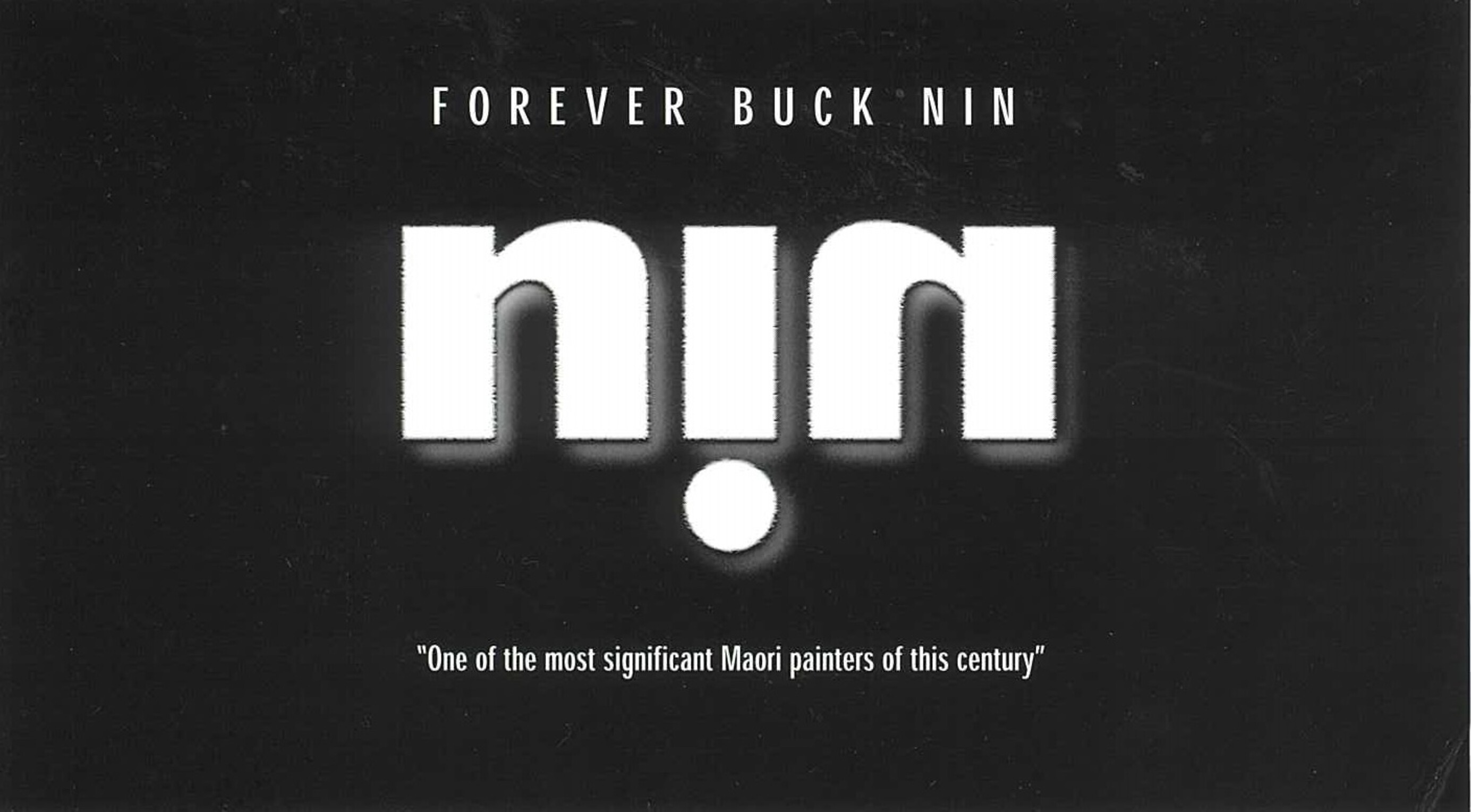This exhibition is now closed
Forever Buck Nin
15 October –
28 November 1999

A major retrospective exhibition celebrates the life and work of Dr Buck Nin, an artist and teacher, and a committed advocate for contemporary Māori Art. Nin died in 1996.
A touring exhibition curated by the Porirua Museum of Art and History, Forever Buck Nin celebrates the life and achievements of Dr Buck Nin, one of the most important Māori artists of the twentieth century, who played a pivotal role in the development of Māori art and art education.
Highly respected by the Māori community, Nin was pro-active in many areas relating to the rejuvenation of Māori culture. He was a significant figure in the restoration of Rongopai, the painted ancestral house of the celebrated Māori leader Te Kooti, and participated in the land marches of the 1970s and the Bastion Point protest. In addition to his political concerns, Nin was sympathetic to environmental and conservation issues. He is also remembered for his various entrepreneurial exploits such as the black velvet portraits of 1966, the microwave hangi, experiments with wind-generated power, developing emergency cardboard box houses and exporting dried meat to China.
Nin was a significant influence in the Aotearoa New Zealand Education Department. He followed in the footsteps of esteemed educator Gordon Tovey and the generation of artists who were involved in the Northern Māori project. He formed close friendships with young Māori artists, the first generation to migrate to urban centres after the Second World War, who were to drive the contemporary Māori art movement. Although freed from the restrictions of their tribal traditions, they were influenced by their heritage as well as American and European culture and art movements.
Dedicated to raising the profile of these artists within Māori society, Nin promoted several exhibitions of contemporary art within the Pākehā art world and Māori cultural contexts. In 1966 Nin approached the Canterbury Museum with the concept of an exhibition of Māori art and sculpture. Initially a simple idea, this exhibition evolved into New Zealand Māori Culture and the Contemporary Scene, one of the first curated exhibitions of contemporary Māori art to be held in Aotearoa New Zealand and the first to be shown in a 'mainstream' institution. Featuring artists Cath Brown, Fred Graham, Mere Harrison, Norman Lemon (Te Whata), Jonathan Mane-Wheoki, Katerina Mataira, Selwyn Muru, Nin, this touring exhibition established a precedent for exhibitions such as Te Waka Toi in 1993. He was one of the founding members of the Māori Artists and Writers Association in 1973. After the successful Māori Artists and Writers at the South Pacific Festival of the Arts at Rotorua in 1976, Nin initiated the Contemporary Māori Art exhibition hosted by the Waikato Art Museum in the same year.
Nin's art is characterised by a distinctive style – vibrant colours combined with traditional Māori motifs drawn from carving, weaving or rafter patterns, spread across a minimalist landscape, in the words of Darcy Nicholas, 'like a sacred cloak.' His later work included weaving, pieces of timber, mirrors and a greater range of colour. By working from light to dark in his work, Nin paralleled the Māori concept of birth from Te Po (pre-existence) into Te Ao, the world of light.
The colour, traditional Māori symbolism and emotional intensity of Nin's art can be seen in paintings such as Night of the Unknown (1975). The stylised buildings in the lower part of the composition, which are repeated throughout Nin's work, may represent the relationship between rural and urban Māori, traditional and modern cultural values, or even the South and North Islands. The repetition of forms, in particular the koru motifs within larger circular forms, and the blue and white colours, serve to unify the composition and suggest the continuity and spiritual power of nature.
Bridging the Gap (1993) is a more hard-edged painting with strong directional movement. Suggesting biculturalism, unification is suggested by the title and the koru forms within the dark mass which link the two diagonal areas of imagery. The abstract nature of the loose areas of brushwork in the lower area of the painting allude to Māori cosmology and the presence of the Gods and whakapapa. Selwyn Muru has described Nin's interpretation of the land in his work as 'forever in a state of change and renewal. Earth and Sky play their own tricks and games. At times eerie light and shadows appear to evoke Hawaiki. Hawaiki of the distant past; Hawaiki in the dimness of time.'
Nin was born in Northland in 1942 of Chinese and Māori ancestry. He was awarded Dux of Northland College in 1960 and, under the influence of Selwyn Wilson, one of the original arts and crfts specialist teachers, attended Elam School of Fine Arts, Auckland for several years. After his marriage to Carol McLanachan in 1965, Nin continued his studies at Ilam and graduated with a Diploma of Fine Arts in 1966. A year later he entered the teaching profession, then in 1978 moved to Hawaii, where he completed a Masters of Education Administration. In 1981, Nin completed his PhD of Arts Administration and Management in United States America. He exhibited extensively in solo and group shows within New Zealand and overseas from 1963 onwards, including Kohia Ko Taikaka Anake – Artists Construct New Directions, National Art Gallery, Wellington, in 1990 and Te Waka Toi – Contemporary Māori Art from NZ in 1992, which toured throughout North America. In 1993, Nin was a finalist in the Visa Gold Art Award.
The concept for this exhibition was conceived by Jonathan Mane-Wheoki, the Gallery's Kaitiaki Māori, in an article on Nin for Art New Zealand. Mane-Wheoki was involved in the curation of the exhibition and wrote the main catalogue essay.
Felicity Milburn
This exhibition was held at the Robert McDougall Contemporary Art Annex in the Arts Centre.
Location:
Robert McDougall Art Gallery - Contemporary Art Annex
Exhibition number: 665